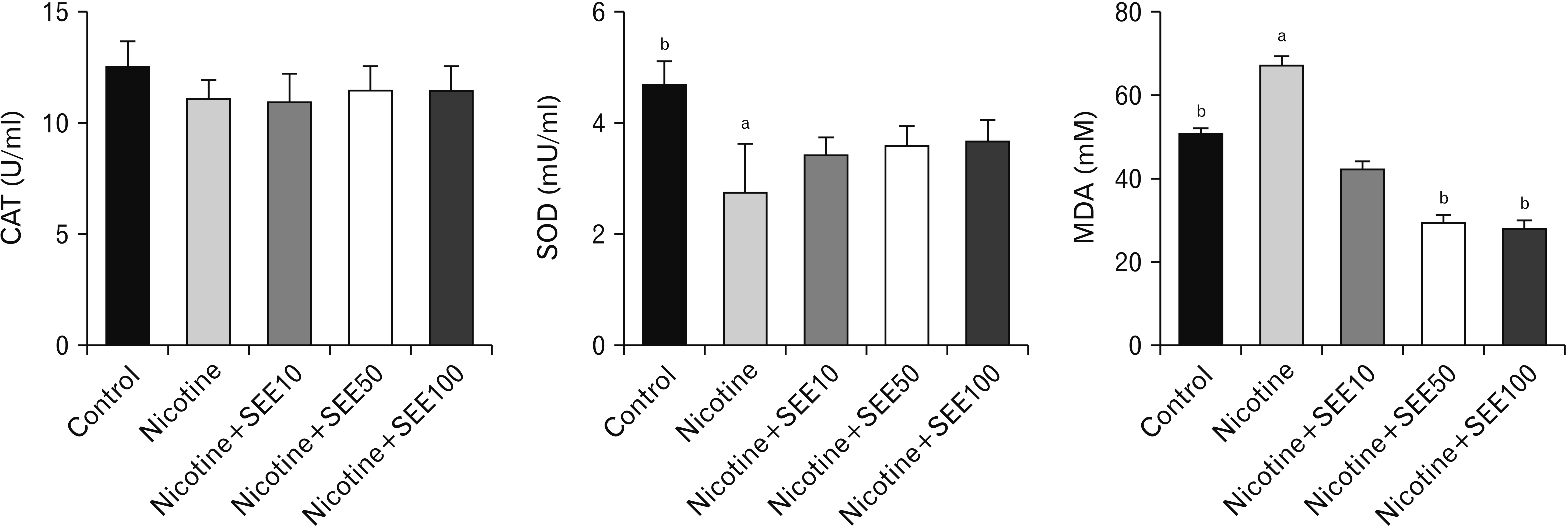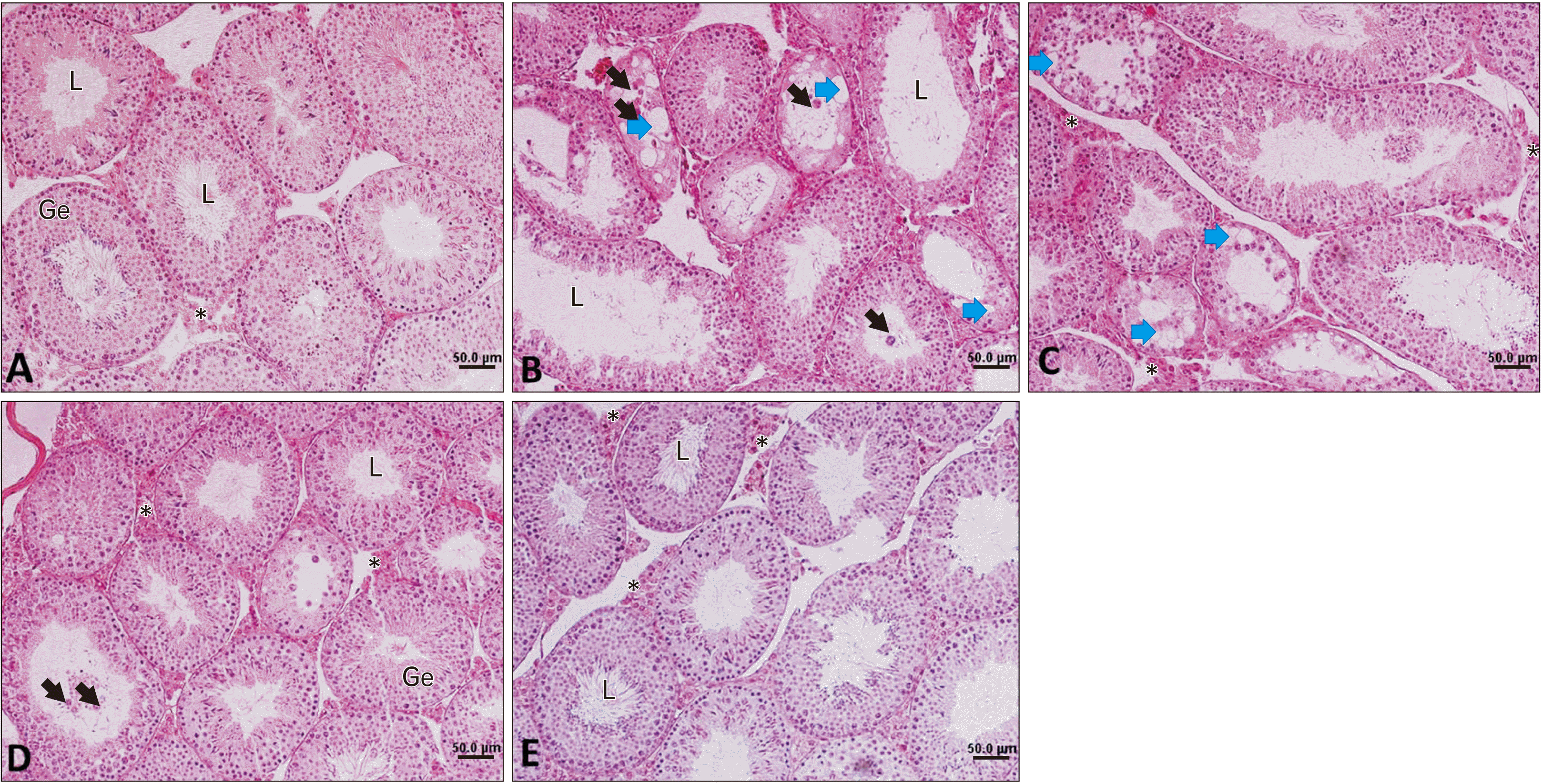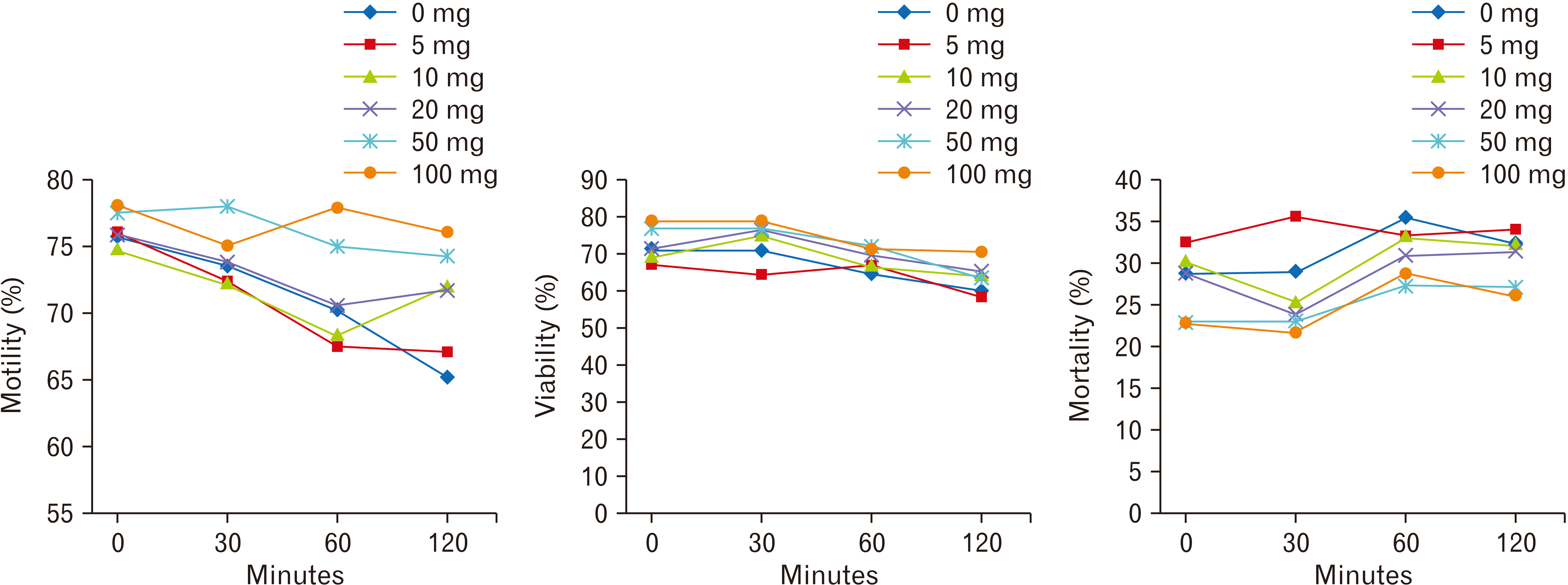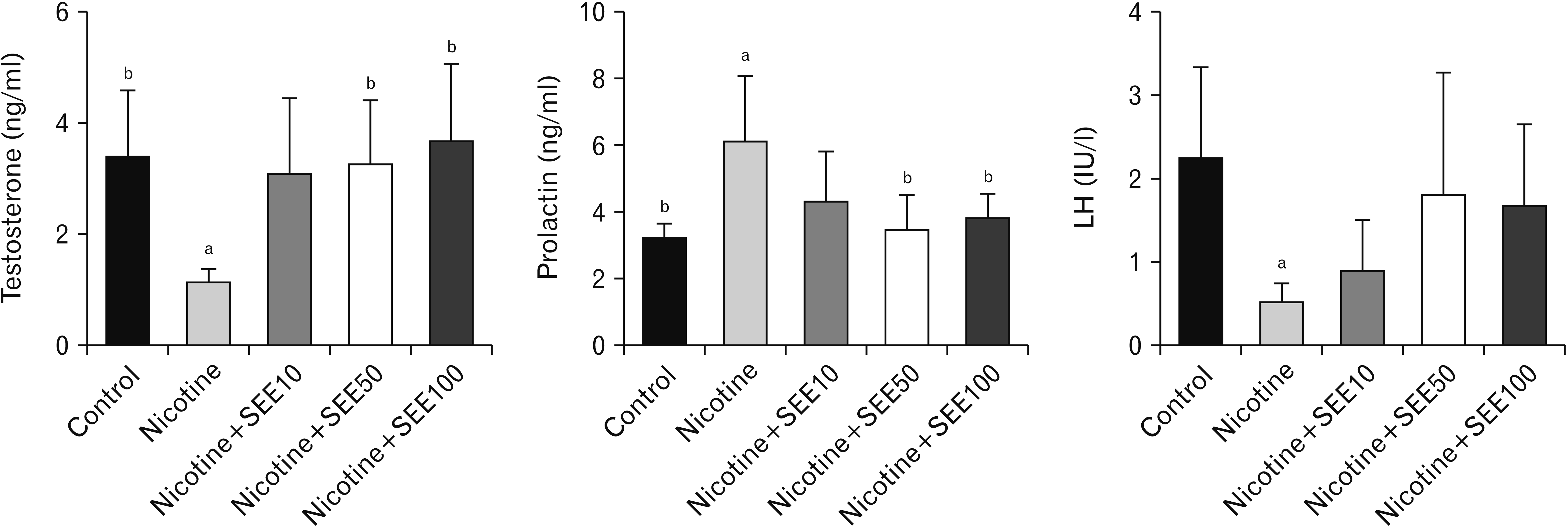2. Chu KM, Cho CH, Shin VY. 2013; Nicotine and gastrointestinal disorders: its role in ulceration and cancer development. Curr Pharm Des. 19:5–10. DOI:
10.2174/13816128130103. PMID:
22950507.

3. Mello PR, Pinto GR, Botelho C. 2001; [The influence of smoking on fertility, pregnancy and lactation]. J Pediatr (Rio J). 77:257–64. Portuguese. DOI:
10.2223/JPED.232. PMID:
14647856.

4. Saadat SN, Mohammadghasemi F, Jahromi SK, Homafar MA, Haghiri M. 2014; Melatonin protects uterus and oviduct exposed to nicotine in mice. Interdiscip Toxicol. 7:41–6. DOI:
10.2478/intox-2014-0007. PMID:
26038675. PMCID:
PMC4427714.
6. Oyeyipo IP, Raji Y, Bolarinwa AF. 2014; Antioxidant profile changes in reproductive tissues of rats treated with nicotine. J Hum Reprod Sci. 7:41–6. DOI:
10.4103/0974-1208.130823. PMID:
24829530. PMCID:
PMC4018797.

7. Oyeyipo IP, Raji Y, Bolarinwa AF. 2013; Nicotine alters male reproductive hormones in male albino rats: the role of cessation. J Hum Reprod Sci. 6:40–4. DOI:
10.4103/0974-1208.112380. PMID:
23869150. PMCID:
PMC3713576.

8. Jana K, Samanta PK, De DK. 2010; Nicotine diminishes testicular gametogenesis, steroidogenesis, and steroidogenic acute regulatory protein expression in adult albino rats: possible influence on pituitary gonadotropins and alteration of testicular antioxidant status. Toxicol Sci. 116:647–59. DOI:
10.1093/toxsci/kfq149. PMID:
20498001.

9. Mohammadghasemi F, Jahromi SK, Hajizadeh H, Homafar MA, Saadat N. 2012; The protective effects of exogenous melatonin on nicotine-induced changes in mouse ovarian follicles. J Reprod Infertil. 13:143–50. PMID:
23926539. PMCID:
PMC3719350.
10. Guo X, Wang H, Wu X, Chen X, Chen Y, Guo J, Li X, Lian Q, Ge RS. 2017; Nicotine affects rat Leydig cell function
in vivo and vitro via down-regulating some key steroidogenic enzyme expressions. Food Chem Toxicol. 110:13–24. DOI:
10.1016/j.fct.2017.09.055. PMID:
28986172.
11. Mohammadghasemi F. Preedy VR, editor. 2020. Melatonin, antioxidant capacity, and male reproductive function. Pathology. Elsevier;London: p. 265–75. DOI:
10.1016/B978-0-12-815972-9.00026-3.

13. Koskinen LO, Collin O, Bergh A. 2000; Cigarette smoke and hypoxia induce acute changes in the testicular and cerebral microcirculation. Ups J Med Sci. 105:215–26. DOI:
10.3109/2000-1967-177. PMID:
11261607.
15. Agarwal A, Leisegang K, Sengupta P. Preedy VR, editor. 2020. Oxidative stress in pathologies of male reproductive disorders. Pathology. Elsevier;London: p. 15–27. DOI:
10.1016/B978-0-12-815972-9.00002-0.

16. Dai J, Zhan C, Xu W, Wang Z, Nie D, Zhao X, Zhang D, Gu Y, Wang L, Chen Z, Qiao Z. 2015; Nicotine elevates sperm motility and induces Pfn1 promoter hypomethylation in mouse testis. Andrology. 3:967–78. DOI:
10.1111/andr.12072. PMID:
26311342.
18. Condorelli RA, La Vignera S, Giacone F, Iacoviello L, Vicari E, Mongioi L, Calogero AE. 2013; In vitro effects of nicotine on sperm motility and bio-functional flow cytometry sperm parameters. Int J Immunopathol Pharmacol. 26:739–46. DOI:
10.1177/039463201302600317. PMID:
24067470.

19. Cvetanović A. Preedy VR, editor. 2020. Sambucus ebulus L., antioxidants and potential in disease. Pathology. Elsevier;London: p. 321–33. DOI:
10.1016/B978-0-12-815972-9.00031-7.

20. Ebrahimzadeh MA, Ehsanifar S, Eslami B. 2009; Sambucus ebulus elburensis fruits: a good source for antioxidants. Phcog Mag. 5:213–8.
21. Shokrzadeh M, Saeedi Saravi SS, Mirzayi M. 2009; Cytotoxic effects of ethyl acetate extract of Sambucus ebulus compared with etoposide on normal and cancer cell lines. Phcog Mag. 5:316–9. DOI:
10.4103/0973-1296.58152.
22. Ivanova D, Tasinov O, Kiselova-Kaneva Y. 2014; Improved lipid profile and increased serum antioxidant capacity in healthy volunteers after Sambucus ebulus L. fruit infusion consumption. Int J Food Sci Nutr. 65:740–4. DOI:
10.3109/09637486.2014.898256. PMID:
24625072.
23. Jabbari M, Hashempur MH, Razavi SZ, Shahraki HR, Kamalinejad M, Emtiazy M. 2016; Efficacy and short-term safety of topical dwarf elder (Sambucus ebulus L.) versus diclofenac for knee osteoarthritis: a randomized, double-blind, active-controlled trial. J Ethnopharmacol. 188:80–6. DOI:
10.1016/j.jep.2016.04.035. PMID:
27125590.

24. Karami M, Ale-Nabi SS, Nosrati A, Naimifar A. 2015; The protective effect of Sambucus ebulus against lung toxicity induced by gamma irradiation in mice. Pharm Biomed Res. 1:48–54. DOI:
10.18869/acadpub.pbr.1.1.48.

27. Nie D, Zhang D, Dai J, Zhang M, Zhao X, Xu W, Chen Z, Wang L, Wang Z, Qiao Z. 2016; Nicotine induced murine spermatozoa apoptosis via up-regulation of deubiquitinated RIP1 by Trim27 promoter hypomethylation. Biol Reprod. 94:31. DOI:
10.1095/biolreprod.115.131656. PMID:
26607717.

28. Emami NH, Lafout FM, Mohammadghasemi F. 2018; Administration of melatonin protects against acetylsalicylic acid-induced impairment of male reproductive function in mice. Iran J Basic Med Sci. 21:124–9. DOI:
10.22038/IJBMS.2017.23833.5989. PMID:
29456808. PMCID:
PMC5811750.
30. Kohestani Y, Kohestani B, Shirmohamadi Z, Faghani M. 2020; Effect of tamsulosin on testis histopathology and serum hormones in adult rats: Experimental study. Int J Reprod Biomed. 18:531–8. DOI:
10.18502/ijrm.v13i7.7370. PMID:
32803117. PMCID:
PMC7385916.

31. Blum J, Fridovich I. 1985; Inactivation of glutathione peroxidase by superoxide radical. Arch Biochem Biophys. 240:500–8. DOI:
10.1016/0003-9861(85)90056-6. PMID:
2992378.

32. Budin SB, Kho JH, Lee JH, Ramalingam A, Jubaidi FF, Latif ES, Zainalabidin S, Taib IS, Mohamed J. 2017; Low-dose nicotine exposure induced the oxidative damage of reproductive organs and altered the sperm characteristics of adolescent male rats. Malays J Med Sci. 24:50–7. DOI:
10.21315/mjms2017.24.6.6. PMID:
29379386. PMCID:
PMC5771515.
33. Suleyman H, Gumustekin K, Taysi S, Keles S, Oztasan N, Aktas O, Altinkaynak K, Timur H, Akcay F, Akar S, Dane S, Gul M. 2002; Beneficial effects of Hippophae rhamnoides L. on nicotine induced oxidative stress in rat blood compared with vitamin E. Biol Pharm Bull. 25:1133–6. DOI:
10.1248/bpb.25.1133. PMID:
12230103.

34. Topuzović MD, Stanković MS, Jakovljević DZ, Bojović BM. 2016; Plant part variability of Sambucus ebulus L. Secondary metabolites content and antioxidant activity. Agro Food Ind Hi Tech. 27:60–3.
35. Shokrzadeh M, Saeedi Saravi SS. 2010; The chemistry, pharmacology and clinical properties of Sambucus ebulus: a review. J Med Plants Res. 4:95–103.
36. Wan T, Wang Z, Luo Y, Zhang Y, He W, Mei Y, Xue J, Li M, Pan H, Li W, Wang Q, Huang Y. 2019; FA-97, a new synthetic caffeic acid phenethyl ester derivative, protects against oxidative stress-mediated neuronal cell apoptosis and scopolamine-induced cognitive impairment by activating Nrf2/HO-1 signaling. Oxid Med Cell Longev. 2019:8239642. DOI:
10.1155/2019/8239642. PMID:
31885818. PMCID:
PMC6914945.

37. Reddy S, Londonkar R, Ravindra , Reddy S, Patil SB. 1998; Testicular changes due to graded doses of nicotine in albino mice. Indian J Physiol Pharmacol. 42:276–80. PMID:
10225057.
38. Seema P, Swathy SS, Indira M. 2007; Protective effect of selenium on nicotine-induced testicular toxicity in rats. Biol Trace Elem Res. 120:212–8. DOI:
10.1007/s12011-007-8021-7. PMID:
17916973.

39. Hondo E, Kurohmaru M, Sakai S, Ogawa K, Hayashi Y. 1995; Prolactin receptor expression in rat spermatogenic cells. Biol Reprod. 52:1284–90. DOI:
10.1095/biolreprod52.6.1284. PMID:
7632836.







 PDF
PDF Citation
Citation Print
Print





 XML Download
XML Download